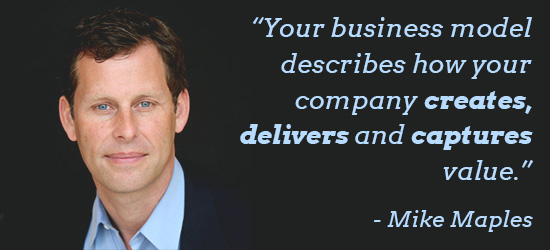
If you are a startup founder, chances are that you would like to raise significant funding, and become a successful company. But as you know, a very small percentage of companies get funded every year, and even fewer of those become successful. It is apparent that there is a large difference between companies like Facebook, Uber and Twitter and the tens of thousands of other startups that you’ve never heard of. But up until this point, it has been nearly impossible to pinpoint exactly what each of those differences are.
Some attribute the success of the giant companies to luck. They were simply in the right place and the right time. And this may be true for many, but even if it was luck, could that just mean that the founders of these companies accidentally stumbled upon this unknown formula that creates a successful tech company?
Mike Maples, Founding Partner of Floodgate and 14th best Angel Investor in the world, may be able to shed some light on this subject for us. In a speech at the Founder Showcase, he described how when he invests in companies, he looks for companies that he calls “thunder lizards.”
My goal is to find 'thunder lizards.' If you look at the facts, for the last 7-8 years about 10,000 companies a year get funded by angel investors, about 1500 are funded by VC’s, and about 15 are worth more than $500M. I call those companies 'thunder lizards.' All I do is chase 'thunder lizards'”
According to Maple’s numbers that would mean that only 0.15% of funded companies become the elusive "thunder lizard."
But what makes a startup that can reach a valuation greater than $500M? To answer that question, Maples dives into his philosophy of what a startup is meant to be, and how common tactics, such as pivoting and testing are key concepts that every founder should deeply understand.
To learn more lessons from startup and venture capital experts, join us for the 16th Founder Showcase - Tuesdsay, May 12th in Silicon Valley. Get your tickets today.
What is a "Thunder Lizard?"
This term refers to a somewhat comical metaphor that Mike Maples created that compares great startups with Godzilla. He says:
The 'thunder lizard' comes out of the ocean angrily, and starts disrupting everything”
The reason that so many great companies seem like Godzilla is because they seem to quickly emerge out of nowhere, and establish themselves and a major player and threat to their competitors (think of companies like Uber.) Whatever market a "thunder lizard" decides to enter, will never be the same as it was before it emerged. Consequently, companies that have “thunder lizard” qualities, are the ones most likely to attract large amounts of investment. Here is what it takes to be a "thunder lizard," according to Maples.
The Qualities of a "Thunder Lizard" Company
1. Wants to be number one
You hear advice all the time that if you want to be successful, you need to have a big vision. It will keep you motivated, and keep your team on the same page. But besides the generic advice, having a large vision impacts companies in more ways than you may have thought possible.
It’s irrational to try to be anything but #1 in your market. It’s a winner take all market.”
Simply put, the more potential your company has, the more attractive you look to investors. The bigger your vision, the more willing investors are to overlook flaws and give you a chance. If you want to become number one in your market, investors will want to help you get there because if you’re number one, they’re number one as well.
If you pitch an investor with an idea that wants to merely compete in a market, no matter how much the investor likes you or your idea, on paper it will not make sense for them to invest. The only way VC’s make money is with companies that have the potential to be the undisputed, number 1 company in their market.
In any tech market #1 is awesome, number 2 is okay, and number 3 is forgotten.”
So the first part of a company becoming a "thunder lizard" is a strong desire to become number one in whatever market you enter.
In order to do this, your company needs to be able to create sustainable value through your business model.
2. Elegant Business Model

The startup doesn’t exist just to ship a product, it exists to find a way to sustain their innovations… A Startup exists to do one, and only one thing. To find a business model.”
Although startups do many things including creating cutting edge products, innovating and changing the world, the sole purpose of one is to find a business model. Having a sound business model is the only way that a small company can raise capital, scale and achieve their large vision. In order to create one
The business model is the diagram of the flows of everything in your company that it takes to produce your product, through distribution and partners, out to the ultimate end users. The best business models are where the greens add up to more than the reds. 90% of the startups that I talk to can’t draw their business model.”
With this in mind, a "thunder lizard’s" main goal is to find a business model that would allow them to become the top performer in their market.
3. Can Handle Pivots
With “pivot” being one of the most overused terms in the startup industry, it has quickly lost it’s meaning when a founder says “We’ve pivoted.” Pivots are not merely about different iterations of your product. It is not about A/B testing. According to Maples
A real pivot is a change to the business model. The key tactical weapon of a startup is the ability to iterate. The strategic weapon is the ability to pivot.”
In order to find the best business models, startups often need to pivot. The team has to be able to handle the uncertainty of trying something new, in order to achieve their vision.
Pivoting is Gut Wrenching. Pivots that matter, involve something that is extremely hard for the founders to let go. You’ve spent years working on it, and you have to let it go.”
But often it is necessary for a company to become the best. It may seem at times that the large players in your industry have all of the advantages like money, talent, partnerships and strong leadership. But as a startup, some of your main advantages are the ability to iterate and pivot, while larger companies often cannot do.
Great startups seek the best potential business model. Great startups have the guts to take aggressive, courageous pivots.”
4. Product Market Fit
If your startup can achieve product market fit, it means that you can do each previous point on this list well. According to Maples, once a startup truly achieves product market fit, that means that it has found a way to offer it’s product to its customers in a scalable way. It means that the startup is ready to start making the transition to become a real company.
Once a startup has product market fit, it really means that you’ve found a good business model that is sustainable.”
Pivots that created amazing companies
To back up Maples' philosophy, he presents a few examples of investments that he has made and how these companies found sustainable business models, product market fit and "thunder lizard" potential.
Example #1: ngmoco:) Mobile Gaming Company.
When ngmoco:) was founded in 2008, mobile gaming was a much different industry than it is today. They were able to release their first game, and sell it for $10 a download. What’s more, is they had a good amount of success doing this. They were able to sell 100K units in 1 month, and things were looking good for them.
But shortly after, the Iphone’s game marketplace began getting swamped with game apps, and the market became very saturated. There was no way that they could sustain their current model, and have a chance at being a “thunder lizard.”
Their average revenue per user at the time was 20-30 $ per user, per year. If they were to look at it that way, there’s no way that you could create a $100M a year business. There’s certainly no way that you could create a billion dollar a year business.
So, as Maples describes it, the founders came in to the board meeting and said that we are going to stop this business model. They decided to start giving it away for free. It was a gutsy call, to want to give up their current revenue stream.
They came up with this formula to calculate their revenue.
Revenue = Daily active users * $ per daily active user
So they did something that was gut wrenching. They decided to start giving away their games for free. With this model they could reach a much wider audience.
If they could have 1 million daily active users, and they could get 5 cents per DAU. Then they’d make $50K a day. Then if they could increase their DAU to 10 million then they would have a real company. There was no path to greatness the old way, but there is this way. They bet it all on that.
And in the end It worked! They were able to achieve a similar number to their projections and got acquired for $400M in under 3 years since they had launched.
Example #2: Product Pivot: Chegg.
Chegg started out as craigslist for students. A short time after they launched, Facebook started offering a very similar service with ecommerce. When Chegg only had 4 months of money left they knew they had to do something substantial in order to achieve their goals. So they decided to become Textbookflix (the later changed their names back to Chegg.) They were now "Netflix for textbooks" and allowed students to easily rent textbooks. Once they decided to do this, their business started to do really well. They had discovered a great business model because they could buy a textbook for a wholesale rate, rent the book for almost as much as it costs, and then get it back and rent it over and over again.
In the end they went public, and are worth around $640M today.
Example #3: Odeo Podcasting company.
Odeo started out as a company that allowed users to easily start a podcast. They were able to spark Maples interest, and he wired them money for an early investment.
A week later, apple launched podcasts in iTunes. Odeo tried to hold out for a while, but eventually realized that their whole business had just been released as a feature of a tech giant's product. The founders decided to do something strange and "refund" the investors.
When the founders wanted to return his money, Maples asked "What are you guys going to work on now?."
They answered "Twitter."
Maples urged them to keep his investment to work on Twitter. They made the pivot from audio blogging, to micro blogging.
The rest is history.
Twitter is worth over $25B today.
Conclusion
If you want your startup to become an ultra success like any of the companies discussed in this article, you have to be willing to do what it takes. You have to be able to weather gut wrenching pivots, and iterate until you find a great business model with enough market potential. Target the number one spot in your industry, and you'll have a chance at becoming a "thunder lizard" company.
To learn more lessons from startup and venture capital experts, join us for the 16th Founder Showcase - Tuesdsay, May 12th in Silicon Valley. Get your tickets today.



